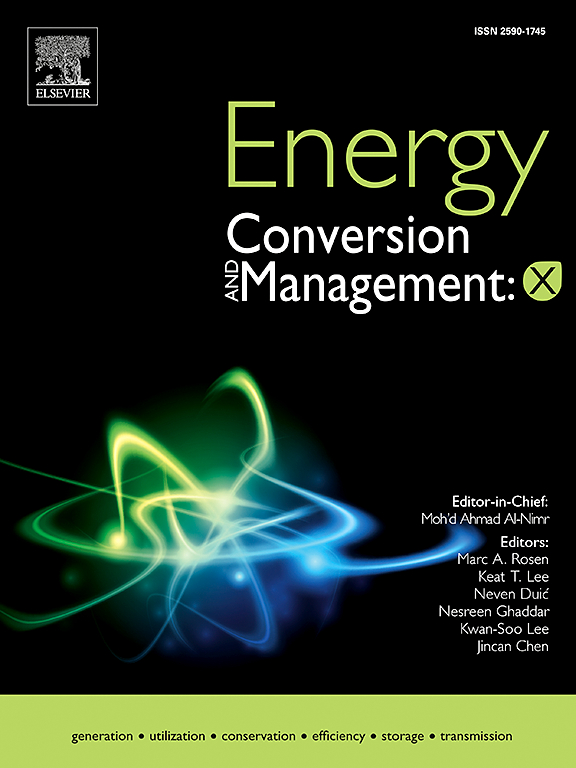Optimizing concentrated photovoltaic module efficiency using Nanofluid-Based cooling
IF 7.1
Q1 ENERGY & FUELS
引用次数: 0
Abstract
Photovoltaic technology offers a promising and environmentally sustainable solution to global energy demands. However, its efficiency is often compromised by elevated temperatures caused by intense solar radiation. Effective cooling strategies are essential to enhance electricity generation and prolong the lifespan of photovoltaic cells. This study explored the enhancement of electricity production in concentrated photovoltaic systems through the use of Al2O3/water nanofluid as a cooling medium. An experimental analysis evaluated the thermal and electrical efficiencies of cooled versus uncooled concentrated photovoltaic panels. Aluminum oxide nanoparticles were utilized in various loadings ranging from 0.2 wt% to 0.5 wt% at a flow rate of 1.25 L/min to assess their impact on concentrated photovoltaic performance. The results demonstrated that 0.5 wt% Al2O3/water nanofluid achieved the most significant reduction in PV surface temperature lowering it by 55 % compared to an uncooled panel. Under peak solar intensity, the electrical output of the concentrated photovoltaic panels was recorded as 43.22 Wh for the uncooled panel. In contrast, the cooled panels produced 48.87 Wh with water, 51.01 Wh with 0.2 wt% Al2O3/water nanofluid, and 54.30 Wh with 0.5 wt% Al2O3/water nanofluid. For the 0.5 wt% Al2O3 nanofluid, the electrical and thermal efficiencies were measured at 34.80 % and 64.42 %, respectively.
利用纳米流体冷却优化聚光光伏组件效率
光伏技术为解决全球能源需求提供了一种前景广阔且环境可持续的解决方案。然而,它的效率经常受到强烈太阳辐射引起的温度升高的影响。有效的冷却策略对于提高光伏电池的发电量和延长寿命至关重要。本研究探讨了通过使用氧化铝/水纳米流体作为冷却介质来提高聚光光伏系统的发电量。一项实验分析评估了冷却与非冷却聚光光伏板的热电效率。在1.25 L/min的流速下,氧化铝纳米颗粒在0.2 wt%至0.5 wt%的不同负荷下使用,以评估其对聚光光伏性能的影响。结果表明,与未冷却的面板相比,0.5 wt% Al2O3/水纳米流体对PV表面温度的降低最为显著,降低了55%。峰值太阳强度下,非制冷聚光光伏板的输出电量记录为43.22 Wh。相比之下,冷却水产生48.87 Wh, 0.2 wt% Al2O3/水纳米流体产生51.01 Wh, 0.5 wt% Al2O3/水纳米流体产生54.30 Wh。对于0.5 wt% Al2O3纳米流体,电效率和热效率分别为34.80%和64.42%。
本文章由计算机程序翻译,如有差异,请以英文原文为准。
求助全文
约1分钟内获得全文
求助全文
来源期刊

Energy Conversion and Management-X
Multiple-
CiteScore
8.80
自引率
3.20%
发文量
180
审稿时长
58 days
期刊介绍:
Energy Conversion and Management: X is the open access extension of the reputable journal Energy Conversion and Management, serving as a platform for interdisciplinary research on a wide array of critical energy subjects. The journal is dedicated to publishing original contributions and in-depth technical review articles that present groundbreaking research on topics spanning energy generation, utilization, conversion, storage, transmission, conservation, management, and sustainability.
The scope of Energy Conversion and Management: X encompasses various forms of energy, including mechanical, thermal, nuclear, chemical, electromagnetic, magnetic, and electric energy. It addresses all known energy resources, highlighting both conventional sources like fossil fuels and nuclear power, as well as renewable resources such as solar, biomass, hydro, wind, geothermal, and ocean energy.
 求助内容:
求助内容: 应助结果提醒方式:
应助结果提醒方式:


